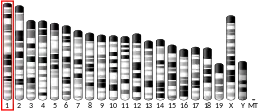Semaphorin-4C is a protein that in humans is encoded by the SEMA4C gene.[5][6]
Interactions
References
- 1 2 3 GRCh38: Ensembl release 89: ENSG00000168758 - Ensembl, May 2017
- 1 2 3 GRCm38: Ensembl release 89: ENSMUSG00000026121 - Ensembl, May 2017
- ↑ "Human PubMed Reference:". National Center for Biotechnology Information, U.S. National Library of Medicine.
- ↑ "Mouse PubMed Reference:". National Center for Biotechnology Information, U.S. National Library of Medicine.
- ↑ Inagaki S, Furuyama T, Iwahashi Y (October 1995). "Identification of a member of mouse semaphorin family". FEBS Lett. 370 (3): 269–72. doi:10.1016/0014-5793(95)00850-9. PMID 7656991.
- ↑ "Entrez Gene: SEMA4C sema domain, immunoglobulin domain (Ig), transmembrane domain (TM) and short cytoplasmic domain, (semaphorin) 4C".
- ↑ Inagaki S, Ohoka Y, Sugimoto H, Fujioka S, Amazaki M, Kurinami H, Miyazaki N, Tohyama M, Furuyama T (March 2001). "Sema4c, a transmembrane semaphorin, interacts with a post-synaptic density protein, PSD-95". J. Biol. Chem. 276 (12): 9174–81. doi:10.1074/jbc.M009051200. PMID 11134026.
Further reading
- Simmons AD, Püschel AW, McPherson JD, Overhauser J, Lovett M (1998). "Molecular cloning and mapping of human semaphorin F from the Cri-du-chat candidate interval". Biochem. Biophys. Res. Commun. 242 (3): 685–91. doi:10.1006/bbrc.1997.8027. PMID 9464278.
- Wang LH, Kalb RG, Strittmatter SM (1999). "A PDZ protein regulates the distribution of the transmembrane semaphorin, M-SemF". J. Biol. Chem. 274 (20): 14137–46. doi:10.1074/jbc.274.20.14137. PMID 10318831.
- Inagaki S, Ohoka Y, Sugimoto H, Fujioka S, Amazaki M, Kurinami H, Miyazaki N, Tohyama M, Furuyama T (2001). "Sema4c, a transmembrane semaphorin, interacts with a post-synaptic density protein, PSD-95". J. Biol. Chem. 276 (12): 9174–81. doi:10.1074/jbc.M009051200. PMID 11134026.
- Ohoka Y, Hirotani M, Sugimoto H, Fujioka S, Furuyama T, Inagaki S (2001). "Semaphorin 4C, a transmembrane semaphorin, [corrected] associates with a neurite-outgrowth-related protein, SFAP75". Biochem. Biophys. Res. Commun. 280 (1): 237–43. doi:10.1006/bbrc.2000.4080. PMID 11162505.
- Nagase T, Kikuno R, Hattori A, Kondo Y, Okumura K, Ohara O (2001). "Prediction of the coding sequences of unidentified human genes. XIX. The complete sequences of 100 new cDNA clones from brain which code for large proteins in vitro". DNA Res. 7 (6): 347–55. doi:10.1093/dnares/7.6.347. PMID 11214970.
This article is issued from Wikipedia. The text is licensed under Creative Commons - Attribution - Sharealike. Additional terms may apply for the media files.





